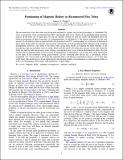Files in this item
Partitioning of magnetic helicity in reconnected flux tubes
Item metadata
| dc.contributor.author | Wright, Andrew N. | |
| dc.date.accessioned | 2019-06-24T16:30:07Z | |
| dc.date.available | 2019-06-24T16:30:07Z | |
| dc.date.issued | 2019-06-20 | |
| dc.identifier | 259377906 | |
| dc.identifier | 27921579-f636-464c-a834-c24d57725bc4 | |
| dc.identifier | 000472226600002 | |
| dc.identifier | 85068966333 | |
| dc.identifier.citation | Wright , A N 2019 , ' Partitioning of magnetic helicity in reconnected flux tubes ' , Astrophysical Journal , vol. 878 , no. 2 , 102 . https://doi.org/10.3847/1538-4357/ab2120 | en |
| dc.identifier.issn | 0004-637X | |
| dc.identifier.other | ORCID: /0000-0002-9877-1457/work/58984311 | |
| dc.identifier.uri | https://hdl.handle.net/10023/17953 | |
| dc.description | A.N.W. was partially funded by STFC Consolidated Grant ST/N000609/1. | en |
| dc.description.abstract | The reconnection of two flux tubes with footpoints anchored to a plane, such as the photosphere, is considered. We focus on properties of the reconnected flux tubes, specifically their twist, which can be quantified using magnetic helicity. If the tubes are of equal flux (Φ) and are initially crossed we find the results are dependent upon the relative positioning of their footpoints: (i) nonequipartition of self-helicity is the typical situation; (ii) the total amount of self-helicity in the reconnected tubes lies between 0 and 2Φ2, corresponding to a total twist of between 0 and 2 turns. If the tubes are initially uncrossed the self-helicity of each reconnected tube depends upon footpoint arrangement. However, care needs to be taken when using these results as bringing the tubes together at the reconnection site can introduce twist or writhe, which will also need to be taken into account. In the case where the tubes are side by side and possess some overlap, reconnection may occur without distorting the tubes. For this situation the reconnected tubes will be crossed: (i) equipartition of self-helicity is never met, but can be approached in the limit of the footpoints being quasi-colinear; (ii) the overlying tube always has a self-helicity whose magnitude >Φ2/2 (it exceeds a half turn); the underling tube's self-helicity magnitude is always <Φ2/2 (less than a half turn). Our results have a broad application in developing models of reconnecting coronal magnetic fields, as well as in interpreting observations and simulations of these fields. | |
| dc.format.extent | 9 | |
| dc.format.extent | 521585 | |
| dc.language.iso | eng | |
| dc.relation.ispartof | Astrophysical Journal | en |
| dc.subject | Magnetic fields | en |
| dc.subject | Magnetic reconnection | en |
| dc.subject | Methods: analytical | en |
| dc.subject | QA Mathematics | en |
| dc.subject | QC Physics | en |
| dc.subject | T-NDAS | en |
| dc.subject | BDC | en |
| dc.subject | R2C | en |
| dc.subject.lcc | QA | en |
| dc.subject.lcc | QC | en |
| dc.title | Partitioning of magnetic helicity in reconnected flux tubes | en |
| dc.type | Journal article | en |
| dc.contributor.sponsor | Science & Technology Facilities Council | en |
| dc.contributor.institution | University of St Andrews. Applied Mathematics | en |
| dc.identifier.doi | https://doi.org/10.3847/1538-4357/ab2120 | |
| dc.description.status | Peer reviewed | en |
| dc.identifier.grantnumber | ST/N000609/1 | en |
This item appears in the following Collection(s)
Items in the St Andrews Research Repository are protected by copyright, with all rights reserved, unless otherwise indicated.

